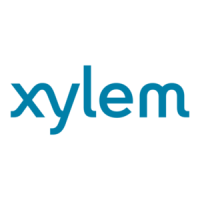
Do you have a question about the Xylem DIQ/S 281 and is the answer not in the manual?
| Protection Class | IP66 |
|---|---|
| Inputs | Digital |
| Display | LCD |
| Electrical Connection | Terminal blocks |
| Ambient Temperature Range | -20 to 50 °C |
| Material | Stainless steel |
| Number of Sensors | 1 or 2 |
Explains the DIQ/S 281's function, main/secondary parameters, and sensor recognition.
Details the functions of the USB and Fieldbus interfaces for system connectivity.
Describes how the system configuration and outputs behave during and after a power interruption.
Provides general safety advice, symbol explanations, and references to further safety documents.
Outlines authorized use, environmental conditions, power source requirements, and opening the product.
Specifies the necessary expertise for operating and installing the transmitter.
Details compliance with regulations, suitability for conditions, and circuit protection.
Outlines measures for protecting against electrical surges and lightning.
Provides instructions for connecting the DIQ/S 281 to power sources.
Guides through the initial system check and start-up procedures.
Describes the display, keypad, and arrow keys used for device control.
Explains how to navigate menus, select items, and confirm actions using the device controls.
Details methods for securing the device, including passwords and electronic keys.
Explains how the system monitors status, generates messages, and logs events.
Outlines the procedure for sensor maintenance, including the maintenance condition.
Describes system security features, authorization levels, and password management.
Covers configuration of sensor parameters like measured value, range, and compensations.
Details how to configure reactions to alarm events, including display messages and relay actions.
Covers general configurations like language, date/time, and environmental parameters.
Explains fundamental relay functions like monitoring, limit indication, and proportional output.
Guides on configuring relay outputs for various functions like system monitoring, cleaning, and alarm contacts.
Details how to configure current outputs for recorder, PID control, or fixed values.
Explains how outputs behave in case of errors or non-operative conditions.
Specifies maintenance requirements for IQ sensors and DIQ modules.
Provides instructions for cleaning the device enclosure and sensors.
Offers troubleshooting steps for common system errors and display messages.
Guides on how to replace passive components and IQ sensors.
Presents detailed technical specifications and dimensions for the DIQ/S 281 transmitter.
Provides dimensional information for mounting the transmitter and accessories.
Lists and explains system error and informative message codes.
Provides contact details for product orders and technical assistance.
Details on how to obtain service and support for YSI products.